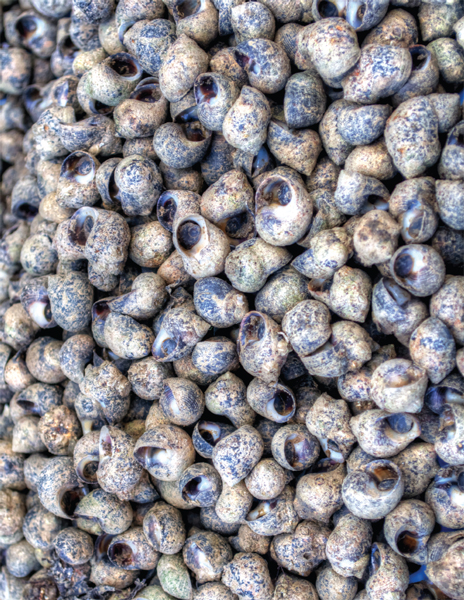

Take half a quart good oysters without their beards, 5 large anchovies pound them together, put to them some chives thyme a good deal of parsley cut very small a lump of butter some crumbs of bread as for scallops put them in your shells and brown them.
—from an 18th century Irish cookbook manuscript
For an island-dwelling nation, over the centuries, the Irish didn’t really embrace fish the way you might imagine. I think in many ways, it was just too much of a good thing. Fish and seafood were everywhere, fast and cheap, so it was food for poor people, and in fact servants’ agreements from the nineteenth century sometimes included clauses that they didn’t have to eat salmon more than a certain number of times per week. (Rich people ate beef, which isn’t that surprising when you consider cows were used as a measure of wealth in ancient Ireland.) It took awhile for us to realize our salmon was (and admittedly, I’m biased) the best in the entire world. It’s so rich and flavorful, moist and curdy—today when I’m home, I gorge myself on salmon, fresh and smoked; when I’m in New York, I spurn lox, because it’s got nothing—and I mean nothing—on Irish smoked salmon, which has a freshness, delicacy, and distinct lack of oiliness that puts other smoked fish to shame.
Nowadays, after the western world’s food revolution, we’ve finally grasped that our fish is something special, so I suppose it makes sense that the finest preparations are the simplest.
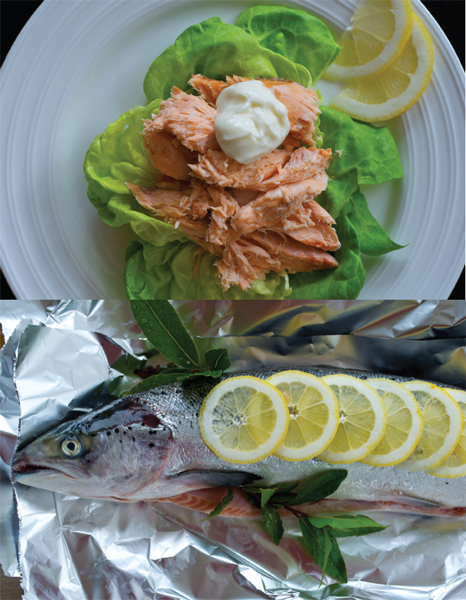
Suppose you come into possession of a whole salmon. There’s not much to do besides cook it whole. Filleting it yourself is a thankless job, and it’s not necessary. Cooked, the flesh flakes off in beautiful chunks. Considering how rich and fatty salmon is, it’s kind of interesting that the sauce that compliments it best is mayonnaise. Together, the two fats meld into a lushness and richness that makes you reach for just one more forkful. Either make a homemade mayonnaise from a recipe you like, or doctor a good-quality mayo with a little extra lemon juice, and serve a bowlful on the side to dollop next to each serving of salmon. If you want the classic over-the-top presentation, seen at parties and buffets, take the skin off the finished salmon, leaving the head intact, and slather the body lavishly with mayo. Then cut thin slices of cucumber and layer them all over the fish like scales.
Makes 8 to 10 servings
Butter
1 whole salmon, 5 to 6 pounds, cleaned and scaled, head and tail intact
Salt and pepper
1 lemon, sliced
Small bunch fresh parsley
1 Preheat the oven to 350 degrees F. Tear off a large sheet of aluminum foil, large enough to wrap the fish, and lay it on a baking sheet. Butter the center of the foil where the fish will be. Lay the fish on the foil and salt and pepper the interior cavity. Stuff the parsley into the cavity and lay the lemon slices on top of the parsley. Dot the exterior with butter along the body and sprinkle with salt and pepper.
2 Tent the foil over the salmon, loosely sealing the top without touching the skin. Bake for 1 ½ hours, until the flesh flakes easily with a fork. Serve warm, at room temperature, or chilled.
GO WILD
Farmed salmon is available in Ireland, but aficionados prefer wild salmon. (True aficionados like to catch their wild salmon themselves!) Wild salmon has very pale pink flesh and a more delicate flavor than farmed. Wild salmon is increasingly available again in the US, and it’s worth seeking out the best, freshest wild salmon you can find to make this recipe. Find out when your fish seller gets the delivery and buy then.
When I was a kid, I loved it when we had fish cakes, and I’m glad to say I have a fish-loving son who feels the same. His eyes light up and he says things like, “Wow, fish cakes?! Hooray! Can I help mix them?” (To keep it in perspective, my other son says things like, “Not for me. Can’t I have peanut butter instead?”) And despite the fact that fish cakes are an excellent way to use up leftover fish and leftover mashed potatoes (as is Family Fish Pie, p. 90), Fish Cakes are still a treat. I like them with a squeeze of lemon and some tartar sauce.
Makes 6 servings
3 cups flaked cooked whitefish fillets or salmon
2 cups leftover mashed potatoes
2 hard-boiled eggs, mashed with a fork
¼ cup chopped fresh parsley
Salt and pepper
1 egg, beaten
¼ cup all-purpose flour
Oil for frying
1 Combine the fish, potatoes, hardboiled eggs, and parsley gently, trying not to break up the fish too much. Taste and add salt and pepper if needed. When the seasoning is correct, gently mix in the beaten egg to bind the mixture.
2 Form into 12 fat little cakes, about 1 inch thick, and set them on a plate. If you want to do this early in the day, cover them with plastic wrap and chill them until you’re ready to cook.
3 When ready to cook them, preheat the oven to 180 degrees F and put the flour on a plate. Stir in ½ teaspoon salt and ¼ teaspoon pepper. Heat about ¼ inch of oil in a large skillet over medium heat. Working in batches, roll the cakes in the seasoned flour and fry in the hot oil, turning once, until golden, about 4 minutes per side. (You may need a little more time if the cakes were refrigerated.)
4 Put the finished cakes on a heatproof platter, and keep them warm in the oven while you finish frying the rest. Don’t crowd the pan, or you won’t have room for flipping without breaking them.
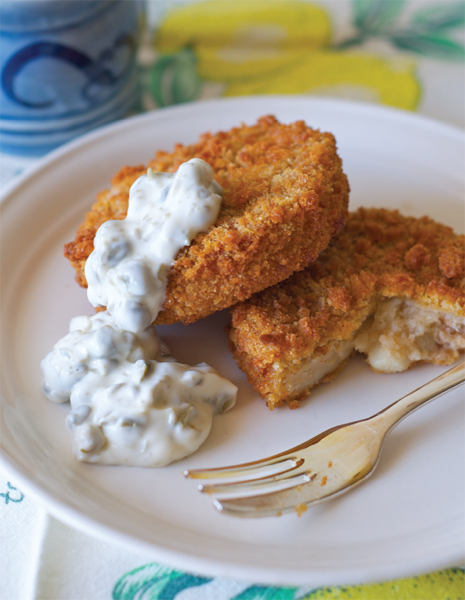
In my experience, there is no fish pie in America when it comes to standard family suppers. Meatloaf, spaghetti, chili—those are the sort of fallbacks that occupy the same place in the American kitchen that fish pie, or Shepherd’s Pie, or Cottage Pie, occupies in the Irish kitchen. This is a good basic version, but you can use any leftover fish and combination of vegetables you have. My brother Andrew, who’s a chef, always uses chopped fennel instead of celery. He’s also the one who advised me to use an equal amount of smoked whitefish with the whitefish for the best flavor (it is good) and to go sparingly on the salmon (avoid smoked salmon) because too much imparts an oily flavor to the pie. A little salmon enriches it—as does the cream.
Makes 6 servings
2 tablespoons butter
1 tablespoon olive oil
2 leeks, white and green parts, thinly sliced and washed
2 sticks celery, roughly chopped
1 large carrot, peeled and shredded
2 tablespoons all-purpose flour
2 teaspoons mustard (either Dijon or a hot English mustard such as Colman’s)
2 cups whole milk or light cream, plus
2 to 3 tablespoons more if needed
¼ teaspoon ground nutmeg
1 sprig rosemary
1 bay leaf
1 pound boneless whitefish fillets (cod, monkfish, turbot, whiting, pollock), cut in small chunks
1 pound smoked fish (smoked trout, smoked haddock), cut in small chunks
8 ounces boneless, skinless salmon, cut into small chunks
½ teaspoon salt (less, or none, if your smoked fish is salty—taste a bit and see)
½ teaspoon black pepper
6 cups mashed potatoes
½ cup shredded cheddar or parmesan
1 Preheat the oven to 350 degrees F and butter a 3 or 4-quart baking dish (you can use a 9 x 13-inch dish but a deeper pan is preferable).
2 Put the oil and butter in a skillet over medium heat. Stir in the leeks, celery, and carrots and cover. Cook for 10 to 12 minutes, until the vegetables are completely tender but not browned.
3 Stir in the flour and mustard, then gradually add in the milk or light cream, stirring constantly to avoid lumps. Add the salt, pepper, nutmeg, rosemary, and bay leaf, and cook for 2 to 3 minutes until the sauce is simmering.
4 Add all the fish pieces, stirring gently to avoid breaking them up too much. Turn this mixture into the prepared dish. Stir the mashed potatoes, adding a bit of milk if necessary to loosen them, and spoon them in an even layer over the fish. Use the tines of a fork to make craggy peaks in the potatoes; this helps make a nicely browned crust later. Top with the cheese and bake for 50 to 60 minutes, until bubbly golden brown on top.
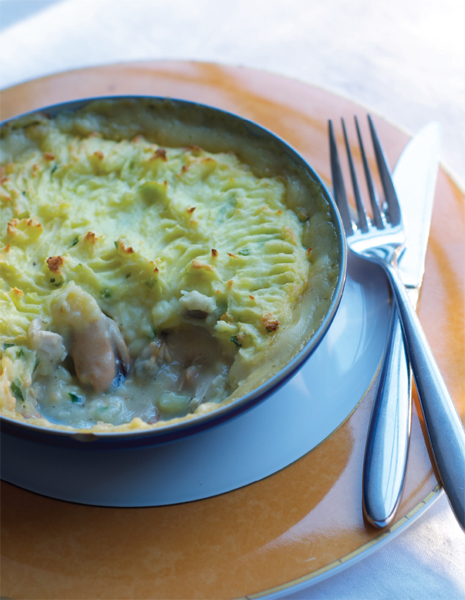
Irish cheese used to be all but nonexistent, but in recent years a new crop of artisan cheese makers has been taking advantage of all the excellent dairy in Ireland to produce some excellent Irish-made cheeses. A cook (not to mention an eater) is spoiled for choice, especially at a cheesemonger such as Sheridans in Dublin, where the finest cheeses lie, aged to perfection, and just begging you to take them home. You can use any hard cheese for this recipe, but avoid fatty, softer cheeses like Havarti or Fontina. Melted, they’re too greasy to work well.
The Italians will tell you cheese and fish never go together. The Irish disagree mightily. The beauty of this is its utter ease—and how well it turns out every time. Use any meaty whitefish that looks good in the market. Haddock is ideal, and I like cod here too.
Make 6 servings
2½ pounds meaty whitefish, such as haddock or cod
Salt and pepper
2 tablespoons mustard, such as Dijon or spicy brown (or 1 tablespoon sharp English mustard such as Colman’s)
2 cups shredded hard cheese, such as cheddar or gruyere
½ cup heavy cream
¾ cup soft breadcrumbs (from 2 slices of bread)
¼ cup chopped fresh parsley
1 Preheat the oven to 375 degrees F and lightly grease a shallow baking dish.
2 Lay the fish fillets in the dish in a single layer or only slightly overlapping, and sprinkle them lightly with salt and pepper. Spread the mustard over the fillets, cover with the cheese, and drizzle with the cream. Scatter the breadcrumbs and parsley over all.
3 Bake for 25 to 30 minutes, until the fish is opaque and the topping is golden brown.
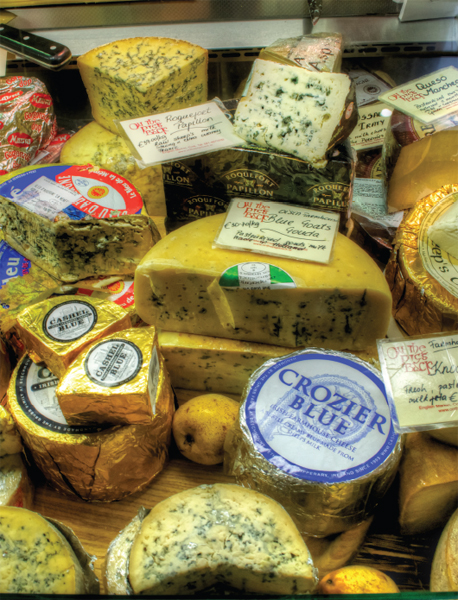
Cheeses at the English Market, Cork
Any Irish cookbook has to contain this traditional recipe, even if we don’t eat it all the time, because the mockery of it so appeals to the Irish the dish lives on and on. Perhaps it’s apocryphal that the name came about because this expensive dish so full of luxury is best suited to, or perhaps only afforded by, those who practice law for a living—in fact, I’m usually suspicious of culinary history that is so pat—but by now it’s an accepted tale and the grim humor of it appeals particularly to post-boom Ireland.
Once you get past that part of the story, it’s an excellent way to loll in the decadence of a good, large crustacean— don’t bother with anything less than the outrageous expense of a two-pound lobster. Considering the whole thing could have easily been prepared over a silver chafing dish, it’s easy to conjure up the scene Thackeray described when he ate Dublin Lawyer on a trip to Ireland in 1847, of pink-cheeked legal gentlemen, merry and bewigged, preparing this in their chambers after a day in court. If you have a chafing dish or hotplate, Dublin Lawyer still makes for excellent tableside drama today. Don’t be frightened by the huge whoosh of flame that comes from setting the hot whiskey alight in the pan; it will burn off in seconds, and you can always clap down a lid if you’re worried. Just keep your face out of the way.
For 2 servings, easily doubled
1 large lobster, about 2 pounds, freshly boiled or steamed
½ cup (1 stick) butter
½ cup Irish whiskey
½ cup heavy cream
Salt and pepper
1 Crack and shell the lobster, removing the meat in large chunks. Depending on the size of the tail, tear or cut it into two or four pieces for easy serving.
2 In a chafing dish or large skillet over a medium heat, melt the butter. As it begins to sizzle (and not a moment later), add the lobster meat to the pan and toss to coat well and heat through, 1 to 2 minutes.
3 Pour in the whiskey. After a moment, when it has heated through (cold whiskey won’t flame), touch a lighted match to the edge of the pan, or, if you’re cooking over flame, tilt the pan so the whiskey’s fumes can come into contact with the light under the pan. The alcohol will burn with a rush, throwing up an exciting and dramatic flame that will burn right off, removing the raw taste of the whiskey and leaving mellow smokiness behind.
4 Pour in the cream and let it bubble. Season liberally with salt and pepper and eat immediately.

Supposing you have a dozen plump, succulent scallops from Dublin Bay, perhaps with the coral still attached, this is the only way to serve them. Irish scallops (and again, I’m deeply biased) are the absolute best I have ever eaten: Fat and flavorful, they are nearly as big as the palm of my hand, and they always have the coral attached. The coral, if you’ve not heard of it, is an orange-red comma of custardy flavor that is best described as analogous to a lobster’s tomalley. Most Irish seafood is in stores the day it’s caught, so the bright pink-orange coral attached is a great indicator of freshness, because it gets discolored very quickly.
In high-quality American fish stores, you may be able to order scallops with the coral attached. Otherwise, look for the plumpest diver scallops you can find. They should be beautifully moist, not at all wet, which is an indication they’ve been soaked in a brine or perhaps (ugh) a preservative. If in doubt, ask.
What about that Beurre Blanc? Kind of French, right? Well, my dad always served them this way, and it’s exquisite, but to be adamantly Irish, just cook them in a large amount of foaming butter until the edges brown and the scallop is white through (do not overcook!), and serve with a generous squeeze of lemon.
Serves 6 as an appetizer or 2 to 3 as a main course
For the beurre blanc:
¼ cup dry white wine
2 tablespoons white wine vinegar
1 small shallot, very finely chopped
2 tablespoons heavy cream
¾ cups (1½ sticks) butter
1 lemon
Salt and pepper
For the scallops:
12 large scallops
Salt and pepper
2 to 3 tablespoons butter
1 For perfection, turn the oven to 180 degrees F and heat the serving plates and a platter while you make the beurre blanc: In a medium-sized heavy saucepan over medium heat, pour the wine and vinegar, and add the shallots. Bring to a boil, reduce heat, and simmer very gently for 5 to 6 minutes, to reduce the liquid by about  , and cook the shallots to just tender.
, and cook the shallots to just tender.
2 Pour in the cream and cook to heat through and thicken slightly. Cut the butter into 8 pieces and drop them in one at a time, whisking well after each addition to fully incorporate the butter into the sauce. When all the butter is added, season with freshly squeezed lemon juice, salt, and pepper. You can do this to taste, adding more or less of all three as you like. (A French chef would strain out the shallots now, but I never do.) Set the beurre blanc aside on the back of the stove to keep warm.
3 Season the scallops on both sides with a little salt and pepper. Put a tablespoon or two of butter in a skillet over medium-high heat. As soon as it sizzles, shake the pan to distribute it evenly and lay in half the scallops, being sure not to overcrowd. Cook for about 4 minutes, until golden on the edge, and then flip, cooking for 3 to 4 minutes until the other side is golden. The flesh should be just white throughout. Remove to the warm platter and cook the remaining scallops the same way.
4 To serve, divide the beurre blanc in pools among the warm plates, reserving a little for the top. Lift the scallops onto the plates and drizzle the rest on top. Serve immediately.
When I went to art college in the west of Ireland, in County Sligo, there were often times when I had too much month left at the end of my money. Because I lived in a cottage on the coast, fortunately I was able to forage for a fair amount of food. There was “sea spinach,” a seaweed that was like nettles when cooked, blackberries, and nettles in season. I was able to catch the occasional rabbit or pheasant, too. But the most reliable source of food was the mussels that clung to the rocks in huge colonies near the old boathouse down by the shore. I gathered them in large quantities, soaked them overnight in fresh water with a little flour in it to disgorge them, then scrubbed off their “beards” and cooked them in many and various ways. This is one of my favorites, sort of like a mussel version of “Clams Casino,” and it’s a standard on Irish menus. In Ireland, you can even buy them already prepped in packages at the grocery store, ready to be popped under a broiler. Serve with fresh lemon wedges, if you like, to squeeze over each as you eat it.
Makes 8 appetizer servings or 4 main course servings
3 pounds fresh, live mussels, shells shut tight
2 cups soft fresh bread crumbs
¼ cup softened butter (or olive oil) ¼ cup grated Parmesan
3 garlic cloves, minced
½ cup chopped parsley
Salt and pepper
1 Preheat oven to 450 degrees F. Scrub the mussels well and be sure they’re all tight shut, or will shut tight if you tap them.
2 Put them in a large soup pot and add about 2 inches of water. Bring it to a boil over high heat, cover and boil for 3 to 4 minutes, until the mussels open.
3 Drain and cool, discarding any unopened mussels. Pull off and discard the upper shell and arrange the mussels on the half shell on a large rimmed baking sheet.
4 Stir together the remaining ingredients, and top each mussel with a spoonful of this mixture. Bake for 5 to 7 minutes, until the topping is bubbly and crisp. Eat hot.
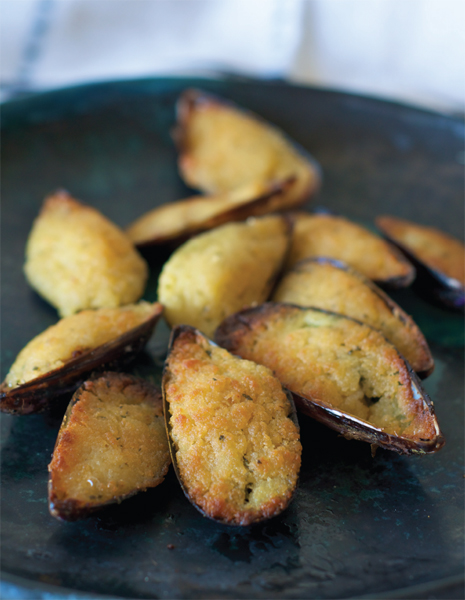
Oysters and Guinness
By now, you may be starting to note the recurrent theme of brown bread and butter as an accompaniment to all sorts of Irish dishes. But nowhere is the trinity so sacred as buttered brown bread with oysters and Guinness. It’s the quintessential taste of Ireland in one bite. Assuming you’re in Ireland, it’s simple to perform the rite:
1 Raise aloft a fresh oyster in its half-shell—with or without a squeeze of lemon, your call—and tip it with all the juices into your eager mouth.
2 Take a bite of buttered brown bread and give the whole thing a couple quick chews.
3 Wash it all down with a slug of creamy and cool Guinness.
Reflect on the pure pleasure, and repeat until you’re done. At an event such as the Galway Oyster Festival, you might not be done until the end of the day or into the night.

They’re like langoustine, and my wife from the American South thought they were crawfish the first time she saw them, but Dublin Bay prawns are a distinct breed, kind of like a cross between a large shrimp and a small, succulent lobster. It’s almost a joke that one of our favorite things to do with them is bread and deep-fry them to be eaten with chips, a deluxe pub snack that’s near-impossible to replicate anywhere else. If you come into possession of a batch of Dublin Bay prawns, your other option is simply to sauté them in butter with some garlic, salt, and pepper, but not only is deep-frying more common, it’s really, really good. Serve the fried prawns with tartar sauce or tangy pink Marie Rose sauce, p. 308—or both.
Makes 2 to 3 servings
Oil for deep-frying
½ cup all-purpose flour
1 teaspoon salt
½ teaspoon black pepper
2 eggs
2 cups breadcrumbs
1 pound Dublin Bay prawns (or langoustines, or large shrimp in a pinch), shelled
1 Put the oil in a large, heavy saucepan, and heat it over medium heat to 365 degrees F (a deep-frying thermometer is indispensable).
2 Put the flour in a bowl and toss it with the salt and pepper. Break the eggs into a bowl and beat them lightly with a fork. Put the breadcrumbs in a bowl. Pat the prawns dry with a paper towel.
3 When the oil is ready, dip each prawn in the flour, then the egg, then the breadcrumbs, turning it in each to coat, and drop it carefully into the hot oil. Work in small batches. Fry them for 5 to 6 minutes, until each one is golden. Use a slotted spoon to lift them onto a paper towel–lined plate. Repeat with remaining prawns. Eat hot.
The ingredients are basic, so freshness counts. Use good potatoes and very fresh fish; a white one such as cod, flounder, sole, whiting, or halibut is best. Although floury russets are more like typical Irish potatoes, yellow-fleshed potatoes such as Yukon Gold make excellent chips, too. Real lard (not the super-processed, supermarket stuff ) does impart a flavor and a perfect finish, but corn, canola, or peanut oil are perhaps more practical as well as good for frying at high temperatures.
Makes 4 hefty servings
4 pounds potatoes
1½ cups flour
1 teaspoon baking soda
½ teaspoon salt
1 cup water
2 quarts of oil for deep-frying
1½ pounds white fish fillets
1 Peel the potatoes and cut them into thick fries. Have a large bowl of cold water nearby, and toss the cut fries into it as you work. Set aside while you make the batter.
2 Combine the flour, baking soda, and salt in a medium bowl, then slowly whisk in water until a smooth paste is formed. Add a little more water if the batter doesn’t lie flat in the bowl—it shouldn’t be thick or fluffy. Cover and set aside to rest for 30 minutes.
3 While the batter rests, heat 2 quarts of oil to 330 degrees F in a large, deep, heavy-bottomed pan with tall sides. (If you don’t have a thermometer, throw in a cube of bread or a fry. If it sizzles, it’s ready, but using a thermometer is best.) Remove the potatoes from the water and dry them well with a clean, absorbent kitchen towel or two.
4 Cook the chips in three or four batches for the first frying. (The second frying can be more crowded.) Carefully put the first batch into the 330 degrees F oil, avoiding crowding, and fry for 5 minutes or until they start to brown, stirring a couple of times to avoid their sticking together. Remove from oil and place them in big bowl well-lined with absorbent paper towels. They should be cooked through and soft, but they’ll look soggy and undercooked.
5 Cut fish filets into 6-inch lengths. (Leave whole if fillets are small.) Make sure oil heat has returned to 350 degrees F. Dip each fillet into batter and slip gently into hot oil. Fry until golden brown, approximately 5 minutes. When the fish is done, drain on a paper towel.
6 Raise the oil heat to 375 degrees F to do the second frying. Put the chips back in, in slightly larger batches, until they are crisp and golden, 1 to 2 minutes. Remove from the oil and drain on fresh paper towels, then season with salt.
7 Serve hot fish and chips immediately, with tartar sauce and ketchup or with salt and malt vinegar (not any other kind of vinegar).


Fay’s Butcher Shop, Thomas St. Dublin
